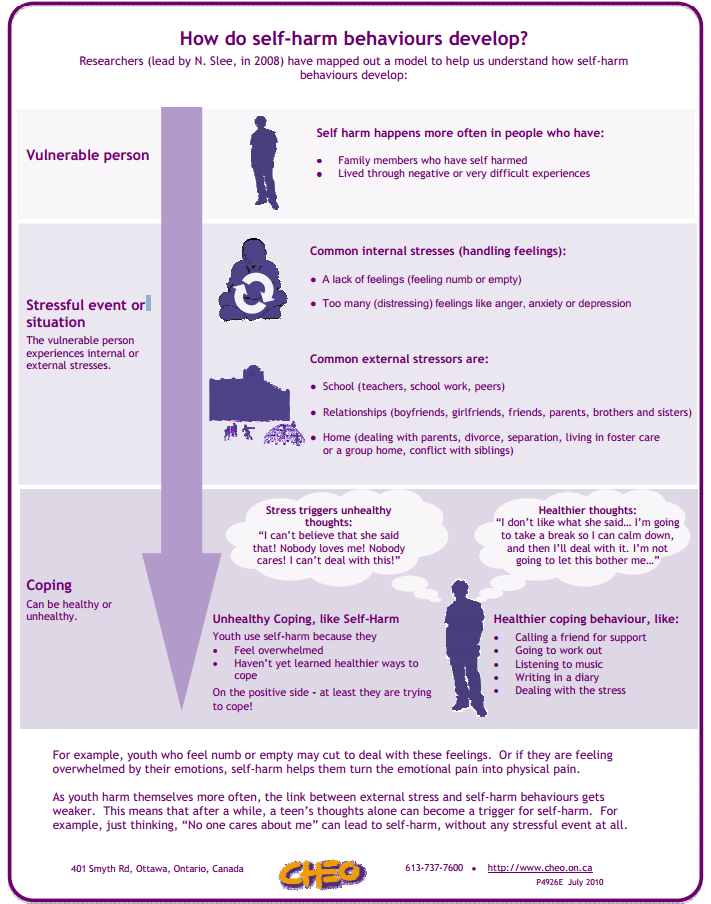It can be very challenging to respond to youth who self harm. It’s even more challenging to respond to youth who self harm when you are the parent or guardian of that youth.
Self harm includes a range of behaviours when people try to hurt themselves on purpose. In this blog post, we’ll discuss how to respond to youth who self harm (without the intention to commit suicide).
2 out of 10 youth between 14 and 21 hurt themselves on purpose. (Source: Children’s Hospital of Eastern Ontario)
There are direct and indirect ways of inflicting self harm:
Direct
- Cutting of the skin
- Burning of the skin
- Over-medicating
- Interfering with healing wounds
- Biting of the skin
- Pinching of the skin
Indirect
- Eating disorders
- Substance abuse
- Physical, situational, or sexual risk taking
While self harm is unhealthy, the reasons behind why people self harm can be healthy. Many youth do it as a way to achieve relief from painful feelings or as a way to try and cope with stress.
How Self-Harm Behaviours Develop
One way self harm initially develops is through word of mouth. Sometimes when youth hear about self harm through friends and social media, they decide to try it in an attempt to make them feel better. However it can become relied upon as a coping mechanism.
However, sometimes self harm is evidence of a failed suicide attempt and sometimes self injurious behaviour can start from an accidental injury and a person continues to harm themselves.
Ask if You Suspect Self Harm
Since this is a very delicate topic to bring up in conversation, you should give yourself enough time for the conversation. The conversation could be abrupt, or it could go on for a while.
Next, prepare yourself to be calm and understanding. It’s also important to remember not to blame the person you suspect is self harming.
During the conversation, maintain eye contact and listen intently. Make sure you give them enough time to talk. Even if they are talking about something that seems to be unrelated, be patient.
During the conversation, you should use Active Listening techniques. However, it’s important to balance between closed and open ended questions. Closed ended questions achieve answers such as “yes” or “no”, whereas open ended questions provoke answers that involve explanations and further elaboration.
Encourage them to talk by leaving some pauses and using phrases such as, “is it okay for you to tell me more about…?”
What You Need to Avoid
You should avoid guilt tripping a youth who self harms. Don’t tell them to just stop. Since self harm is a form of coping for the youth, it can be dangerous to take that away when they haven’t mastered other ways to cope.
How You Can Help
Seek counseling and other mental health services in your area.
In addition to bringing the youth to see a mental health physician, there are many steps you can take to let help a youth who self harms. You can:
- Communicate that you care
- Accept the youth’s feelings
- Learn basic first aid
- Be non-judgmental and let them know you won’t be angry
- Suggest distractions that trigger different senses like listening to music, working out, chewing gum, massages, and scented baths
- Create a list of resources that the youth can use and reassure them that their calls or meetings will be confidential
It’s incredibly important for youth who self harm to see mental health professionals. Being supportive is not enough because the youth still needs to learn and apply different coping techniques.
Always consult with a mental health professional and ensure the person who is self harming is getting the mental health support they need. You can also request for the mental health professional to come up with a safety plan.


